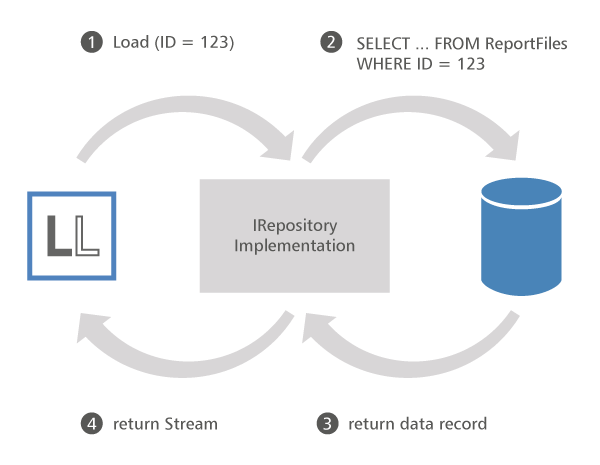| Class | Description | |
|---|---|---|
 | NoHierarchyAttribute | |
 | RepositoryHelper | |
 | RepositoryImportUtil | Helper class for repositories to support the import of local files. See the IRepository-Interface for more information on repositories. |
 | RepositoryItem | Represents an repository item in a repository. |
 | RepositoryItemDescriptor | Provides access to the descriptors of repository items. |
 | RepositoryItemDescriptorCrossPlatformObject | |
 | RepositoryItemType | Provides the predefined repository item types of List & Label. |
 | RepositoryValidator | |
 | SingleThreadedAttribute |
If reports are to be used in distributed applications such as web applications, all required files need to be shared between the systems involved or between the client and the server and kept synchronized at all times. Hence, it is a good idea to save the project files in a central database. However, this solution can become rather complex, especially when a project references pictures, drilldown projects, and other external files via local data paths, which then also need to be valid on another system.
With repository mode, the use of local files in a project can be done away with entirely, and List & Label projects as well as all the files they require can be managed at a central location (the so-called repository) with little effort - such as in a database or by a web service.
Basic Principles
In repository mode, List & Label does not save and load the files used in a report on its own. Instead of file paths and names, unique repository IDs are used. You will need to implement the IRepository Interface yourself and pass it to the ListLabel object. From this point onwards, List & Label will query your user-defined repository for the file content belonging to a repository ID, or transmit the ID along with the corresponding file content to the repository to be saved. Whether the files in the repository are managed by an SQL database, a web service, or some other storage solution depends entirely on your IRepository implementation. In this case, loading and saving of entries in the repository takes place exclusively via streams.
The following schematic diagram shows how a report with the ID "123" is loaded via an IRepository implementation managing an internal SQL database:

Implementation
Since we no longer work with file paths internally, but with repository IDs, it is important to understand their structure. A repository ID is a string consisting of two parts with the following structure:
Prefix: repository://
ID: {53F875F0-6177-8AD5-01B44E3A9867}
Sample: repository://{53F875F0-6177-8AD5-01B44E3A9867}
All functions such as Design, Print, Export, ProvideInformationReadOnlyBase.RepositoryId in WebReportDesignerController.OnProvideListLabel etc., which previously received the file path of the project (e.g., C:\Reports\Invoice.lst), now receive the complete repository ID (e.g., repository://{53F875F0-6177-8AD5-01B44E3A9867}) instead. All functions of the implementation of the IRepository interface are also passed the complete repository ID (prefix + ID) as a parameter. In repository mode, “files” become “repository items” (elements) and file names become “repository IDs.” In addition to the ID, each repository item (element) has a type, a timestamp, and an identifier (variable-length string containing internal information). Your repository implementation must therefore be able to store and retrieve at least these four pieces of information for each repository item (element) in addition to the file content.
Since we no longer work with file paths internally, but with repository IDs, it is important to understand their structure. A repository ID is a string consisting of two parts with the following structure:
Prefix: repository://
ID: {53F875F0-6177-8AD5-01B44E3A9867}
Sample: repository://{53F875F0-6177-8AD5-01B44E3A9867}
All functions such as Design, Print, Export, ProvideInformationReadOnlyBase.RepositoryId in WebReportDesignerController.OnProvideListLabel etc., which previously received the file path of the project (e.g., C:\Reports\Invoice.lst), now receive the complete repository ID (e.g., repository://{53F875F0-6177-8AD5-01B44E3A9867}) instead. All functions of the implementation of the IRepository interface are also passed the complete repository ID (prefix + ID) as a parameter. In repository mode, “files” become “repository items” (elements) and file names become “repository IDs.” In addition to the ID, each repository item (element) has a type, a timestamp, and an identifier (variable-length string containing internal information). Your repository implementation must therefore be able to store and retrieve at least these four pieces of information for each repository item (element) in addition to the file content.
Here you can find a instruction how to use the repository:
You will find a complete simple repository implementation in the ASP.NET sample projects (class SQLiteFileRepository) which provides a repository with an SQLite database for data storage.
Tips
- Use the class RepositoryImportUtil to import existing local files and/or create new projects in the repository.
- You can use the RepositoryItemDescriptor class to change the display name shown in the selection dialogs in the Designer instead of the internal repository ID.
- Accessing the repository takes place sequentially. However, if you use the same repository object for multiple List & Label instances, or if the data storage used is not thread-safe, then synchronization is required.
- Web applications: In order to be able to add large files into the repository, the two parameters maxRequestLength and executionTimeout should be set in the web.config to sufficiently large values. This is also shown in the included ASP.NET samples.
| Interface | Description | |
|---|---|---|
 | IRepository | Represents a storage for the files that a List & Label project depends on, e.g. drilldown projects, includes, images, shapefiles, etc. Once a repository is active, those external files are referenced via an ID instead of local file paths. The IRepository implementation is responsible for storing and loading the contents and metadata information (RepositoryItemDescriptor) of the items in the repository. A exemplary manual could be found at Using the Repository-Mode. |